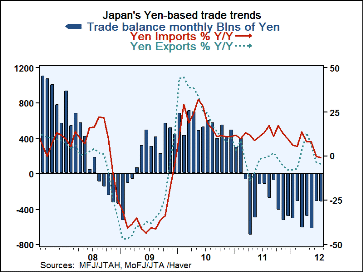 Global| Aug 22 2012
Global| Aug 22 2012Japan's Trade Flows Slow
Summary
Japan’s trade trends have remained firmly riveted in place with its goods trade position in deficit for 17 months running and its export and import trends in a clear decelerating phase. Japan is caught between some powerful forces [...]
 Japan’s trade trends have remained firmly riveted in place with its goods trade position in deficit for 17 months running and its export and import trends in a clear decelerating phase.
Japan’s trade trends have remained firmly riveted in place with its goods trade position in deficit for 17 months running and its export and import trends in a clear decelerating phase.
Japan is caught between some powerful forces that will remain in play for some time. Its export markets in China and in Europe are weak and economies in those two regions are still under what may be increasing downward pressures. Japan has shuttered its nuclear facilities creating a much stronger need for fuel imports than in the past and its longer run position on the use of nuclear fuel is under scrutiny. The yen has moved up sharply and stayed there curtailing competitiveness; it has stayed (numerically) below an exchange rate to the dollar of 80 for the last 12-months. Japan is still shaking off the Economic impact of its triple disasters of over one year ago. Attempts to rely on outsourced production in Thailand were blunted by severe Thai flooding. Japan has also chosen this moment in time to hike its consumption tax and to try and deal with its problem of having such a huge stock of domestic debt.
Japan’s population is now shrinking instead of growing. So add up these factors and you see some real lasting changes for Japan’s trade flows. These are, for the most part, not temporary factors that will switch around and alleviate the pressure on current trends. Japan is in for a long slog although there are some signs that it may be breaking out of its long struggle with deflation.
The strong yen hurts Japan’s ability to export, but it does soften the blow on the costliness of oil imports. Yr/Yr exports are weaker than imports but imports are starting to turn sharply lower.
Robert Brusca
AuthorMore in Author Profile »Robert A. Brusca is Chief Economist of Fact and Opinion Economics, a consulting firm he founded in Manhattan. He has been an economist on Wall Street for over 25 years. He has visited central banking and large institutional clients in over 30 countries in his career as an economist. Mr. Brusca was a Divisional Research Chief at the Federal Reserve Bank of NY (Chief of the International Financial markets Division), a Fed Watcher at Irving Trust and Chief Economist at Nikko Securities International. He is widely quoted and appears in various media. Mr. Brusca holds an MA and Ph.D. in economics from Michigan State University and a BA in Economics from the University of Michigan. His research pursues his strong interests in non aligned policy economics as well as international economics. FAO Economics’ research targets investors to assist them in making better investment decisions in stocks, bonds and in a variety of international assets. The company does not manage money and has no conflicts in giving economic advice.






